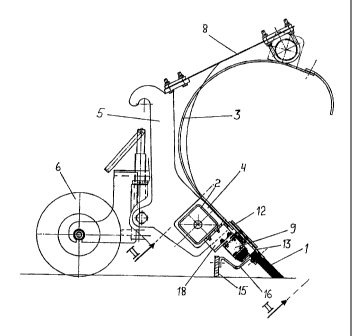Une partie des informations de ce site Web a été fournie par des sources externes. Le gouvernement du Canada n'assume aucune responsabilité concernant la précision, l'actualité ou la fiabilité des informations fournies par les sources externes. Les utilisateurs qui désirent employer cette information devraient consulter directement la source des informations. Le contenu fourni par les sources externes n'est pas assujetti aux exigences sur les langues officielles, la protection des renseignements personnels et l'accessibilité.
L'apparition de différences dans le texte et l'image des Revendications et de l'Abrégé dépend du moment auquel le document est publié. Les textes des Revendications et de l'Abrégé sont affichés :
| (12) Brevet: | (11) CA 2584046 |
|---|---|
| (54) Titre français: | MONTAGE D'ELEMENT DE LAME DANS UN CHASSE-NEIGE |
| (54) Titre anglais: | BLADE ELEMENT MOUNTING IN A SNOW PLOUGH |
| Statut: | Réputé périmé |
| (51) Classification internationale des brevets (CIB): |
|
|---|---|
| (72) Inventeurs : |
|
| (73) Titulaires : |
|
| (71) Demandeurs : |
|
| (74) Agent: | BERESKIN & PARR LLP/S.E.N.C.R.L.,S.R.L. |
| (74) Co-agent: | |
| (45) Délivré: | 2014-08-19 |
| (86) Date de dépôt PCT: | 2005-10-11 |
| (87) Mise à la disponibilité du public: | 2006-04-20 |
| Requête d'examen: | 2010-10-08 |
| Licence disponible: | S.O. |
| (25) Langue des documents déposés: | Anglais |
| Traité de coopération en matière de brevets (PCT): | Oui |
|---|---|
| (86) Numéro de la demande PCT: | PCT/FI2005/000434 |
| (87) Numéro de publication internationale PCT: | WO2006/040396 |
| (85) Entrée nationale: | 2007-04-10 |
| (30) Données de priorité de la demande: | ||||||
|---|---|---|---|---|---|---|
|
La présente invention décrit une suspension flexible d'un élément de coutre (1) d'un chasse-neige pourvu d'un corps (5), d'une lame (3) qui le prolonge, l'élément de coutre (1) entrant en contact avec la surface destinée à être déneigée, une inclinaison appropriée dans ce but, par exemple un angle d'attaque, étant agencée pour l'élément de coutre (1). L'élément de coutre (1) est installé pour reculer afin d'éviter un obstacle dans son angle d'attaque, moyennant quoi l'agencement de fixation de l'élément de coutre (1) présente un espace ouvert formé pour une plaque mobile (13) prolongeant l'élément de coutre, ladite plaque mobile étant agencée pour glisser dans ledit espace, et l'agencement comprend un organe à ressort (9) dont l'impact du ressort est agencé pour empêcher l'élément de coutre de reculer.
Flexible suspension of colter element (1) of a snowplough furnished with a
body (5), a blade (3) as its extension, colter element (1) that gets in
contact with the surface to be ploughed, where for the colter element (1) a
tilt suited for the purpose is arranged, a.o. a cutting angle. Colter element
(1) is fitted to dodge an obstacle in its cutting angle by backing up, whereby
the fixing arrangement of colter element (1) has an open space formed for
moving plate (13) fitted as extension of the colter element, in which space
said moving plate is arranged to glide, and the arrangement includes a spring
organ (9) the spring impact of which is arranged to hinder the colter element
from backing up.
Note : Les revendications sont présentées dans la langue officielle dans laquelle elles ont été soumises.
Note : Les descriptions sont présentées dans la langue officielle dans laquelle elles ont été soumises.

Pour une meilleure compréhension de l'état de la demande ou brevet qui figure sur cette page, la rubrique Mise en garde , et les descriptions de Brevet , États administratifs , Taxes périodiques et Historique des paiements devraient être consultées.
| Titre | Date |
|---|---|
| Date de délivrance prévu | 2014-08-19 |
| (86) Date de dépôt PCT | 2005-10-11 |
| (87) Date de publication PCT | 2006-04-20 |
| (85) Entrée nationale | 2007-04-10 |
| Requête d'examen | 2010-10-08 |
| (45) Délivré | 2014-08-19 |
| Réputé périmé | 2015-10-13 |
Il n'y a pas d'historique d'abandonnement
| Type de taxes | Anniversaire | Échéance | Montant payé | Date payée |
|---|---|---|---|---|
| Le dépôt d'une demande de brevet | 400,00 $ | 2007-04-10 | ||
| Taxe de maintien en état - Demande - nouvelle loi | 2 | 2007-10-11 | 100,00 $ | 2007-04-10 |
| Enregistrement de documents | 100,00 $ | 2007-07-10 | ||
| Enregistrement de documents | 100,00 $ | 2008-09-12 | ||
| Taxe de maintien en état - Demande - nouvelle loi | 3 | 2008-10-14 | 100,00 $ | 2008-09-19 |
| Taxe de maintien en état - Demande - nouvelle loi | 4 | 2009-10-13 | 100,00 $ | 2009-09-18 |
| Requête d'examen | 800,00 $ | 2010-10-08 | ||
| Taxe de maintien en état - Demande - nouvelle loi | 5 | 2010-10-12 | 200,00 $ | 2010-10-08 |
| Enregistrement de documents | 100,00 $ | 2010-11-09 | ||
| Taxe de maintien en état - Demande - nouvelle loi | 6 | 2011-10-11 | 200,00 $ | 2011-09-29 |
| Enregistrement de documents | 100,00 $ | 2011-11-24 | ||
| Taxe de maintien en état - Demande - nouvelle loi | 7 | 2012-10-11 | 200,00 $ | 2012-10-01 |
| Taxe de maintien en état - Demande - nouvelle loi | 8 | 2013-10-11 | 200,00 $ | 2013-10-10 |
| Taxe finale | 300,00 $ | 2014-05-21 |
Les titulaires actuels et antérieures au dossier sont affichés en ordre alphabétique.
| Titulaires actuels au dossier |
|---|
| AL-JON MANUFACTURING LLC |
| Titulaires antérieures au dossier |
|---|
| FORTBRAND SERVICES, INC. |
| HAGIE MANUFACTURING COMPANY |
| PATRIA VAMMAS OY |
| RUUSKA, MAUNO |